When start a dropshipping business, a question beginner or even veteran dropshippers ask a lot is, “How do I brand my store?.”
Some people might go on and say, “You need to create a beautiful logo, use distinctive colors, have a great dropshipping niche, sell winning dropshipping products, offer great customer service, etc.”
Although it’s true to some extent, it’s not the whole story. Or, to make it more extreme, it’s not branding at all.
In this post, we’ll gonna try our best to explain what branding actually is and give you a comprehensive framework to start building a great dropshipping brand.
What Really is Branding?
In a traditional approach, branding is the process of shaping customers’ perception of a company through its logo, design, mission, vision, products, and services.
Even though the definition is true, it seems to give the wrong impression about branding. Specifically, it focuses too much on the various elements going into building a brand but doesn’t tell you what branding really is.
Think about Tesla for a moment. Do people love the brand because of how beautiful the logo is? Or how great the Model S is?
No. It’s more about its CEO – Elon Musk. He is a phenomenal person with an ambitious goal, an unusual personality, and a great story. We want to follow his journey towards the greatest. That’s why we love the brand Tesla.
In the book The Brand Gap written by Marty Neumeier – Director of CEO Branding at Liquid Agency, he noted, “A brand is a person’s gut feeling about a product, service or organization.” Additionally, he adds ‘”Your brand isn’t what you say it is. It’s what they say it is.“
This definition perfectly conveys the whole concept of branding. It’s not your logo, tagline, or design that makes a brand. It’s how your customers feel about it.
Why Do You Need to Brand Your Dropshipping Store And Products?
Branding is critical to the long-term success of a business. It’s how people perceive a company. Therefore, branding can make or break your dropshipping business. For example, if a customer doesn’t have a good experience with your store, which is an element of branding, he/she would very likely never buy from your store again.
In fact, many dropshipping stores thrive and become successful until this day because they have excellent branding. As long as you can build a great brand, dropshipping is not dead.
Besides the obvious reason, branding can also bring many benefits to your dropshipping business:
- Gain advantages against your competitors: A great brand can attract more customers, even if the price is a little bit higher.
- Turn buyers into loyal customers: A great brand like Apple can make people come back to buy again and again.
- Increase business value: Wonder why Apple can charge their products at a high price? Yeah, it’s branding.
The Ultimate Guide to Brand Your Dropshipping Business
1. Understand The Anatomy of a Strong Dropshipping Brand
A brand is built on hundreds of elements, from visual components like logos or colors to abstract principles such as values and messages.
By breaking them down and merging them strategically into related parts, you can develop a uniform framework as a guide to build a strong brand.
In the case of dropshipping businesses, the brand’s anatomy is often much simpler than that of normal companies.
The reason is that dropshipping stores resell other people’s goods, meaning that they don’t produce unique products (unless they strictly private-label the products).
Furthermore, many dropshippers opt for testing-advertising-scaling-selling-exiting (TASSE) models, which refers to when dropshippers quickly test and promote a dropshipping product through ads. If it’s a winning one, they rapidly scale the ad campaigns, sell the product fast, and finally exit. In this case, it’s not necessary to waste time and effort on building a complete brand.
Having said that, here’s the anatomy of a strong and comprehensive dropshipping brand. You can choose to cut out some parts or keep all depending on whether you want to build a short-term brand or a long-term one.

And here’s a simplified version for dropshippers looking for a quick and simple branding solution.

2. Develop Your Brand Purpose
A brand comes first with a purpose, not a name or a logo.
Many dropshipping store owners think that to make a great brand, they have to come up with a catchy domain name or a beautiful logo. Although they’re necessary, they’re not the elements that define a brand.
Remember, “People don’t buy what you do. They buy why you do it.” – Simon Sinek said in the “Start with Why” book.
So, what is a brand purpose?
The brand purpose is the reason why a brand exists aside from commercial intents. Yeah, at the end of the day, your primary goal is to make money. However, it’s vital to understand what meaningful motives behind your action. Essentially, you have to answer the question: “Why do we exist besides making money?.“
For example, Apple’s brand purpose is “To empower creative exploration and self-expression.” And Nike’s is “To bring inspiration and innovation to every athlete in the world (and everybody is an athlete).”

Here is another example from one of the most famous dropshipping stores – Inspire Uplift: “Make your home a better place to be, or give your friend a gift they won’t forget.”

To develop your dropshipping brand purpose, ask yourself 3 questions:
- Why do I do what I do?
- What do I want to achieve?
- Is it meaningful for others or the world?
The answer for the third question should be a resounding yes. If not, you fail to establish your brand purpose.
3. Create Your Mission and Vision Statement
Next, it’s time to put what you have come up with into transparent written statements. Doing this helps you clearly communicate with your customers about your brand purpose.
Mission Statement
A mission statement is a short paragraph that defines the existence of your brand. It aims at explaining why your brand is born rather than how it is born. In short, it answers the question: “Who are we?.”
In order to create the mission statement for your dropshipping brand, a simple framework you can use is as follows:
To help/make/empower/bring/connect people ____ through ____, so ____.
Top brands use this framework frequently in one form or another.
For instance, Disney’s mission statement is “to entertain, inform and inspire people around the globe through the power of unparalleled storytelling, reflecting the iconic brands, creative minds and innovative technologies that make ours the world’s premier entertainment company.”
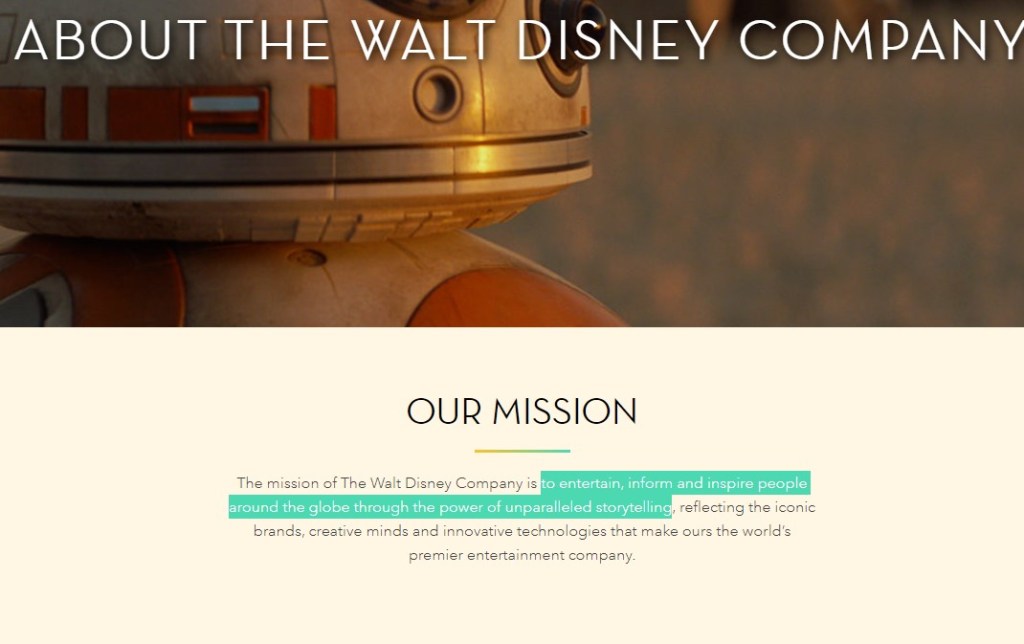
And, here is from Inspire Uplift: “to make our customers happier, more joyful people with products that are as affordable as they are fun to use.”

Vision Statement
A vision statement is a short paragraph that describes the goals of your brand and the picture it hopes to become in the future. It also serves as your motivation to move the company forward. In short, it answers the question: “Where do we want to go?.“
Similarly, a simple framework to create the vision statement for your dropshipping brand is as below:
To be/create/become the leader in ____ by ____, so ____.
For example, Tesla’s vision statement is: “To create the most compelling car company of the 21st century by driving the world’s transition to electric vehicles.”
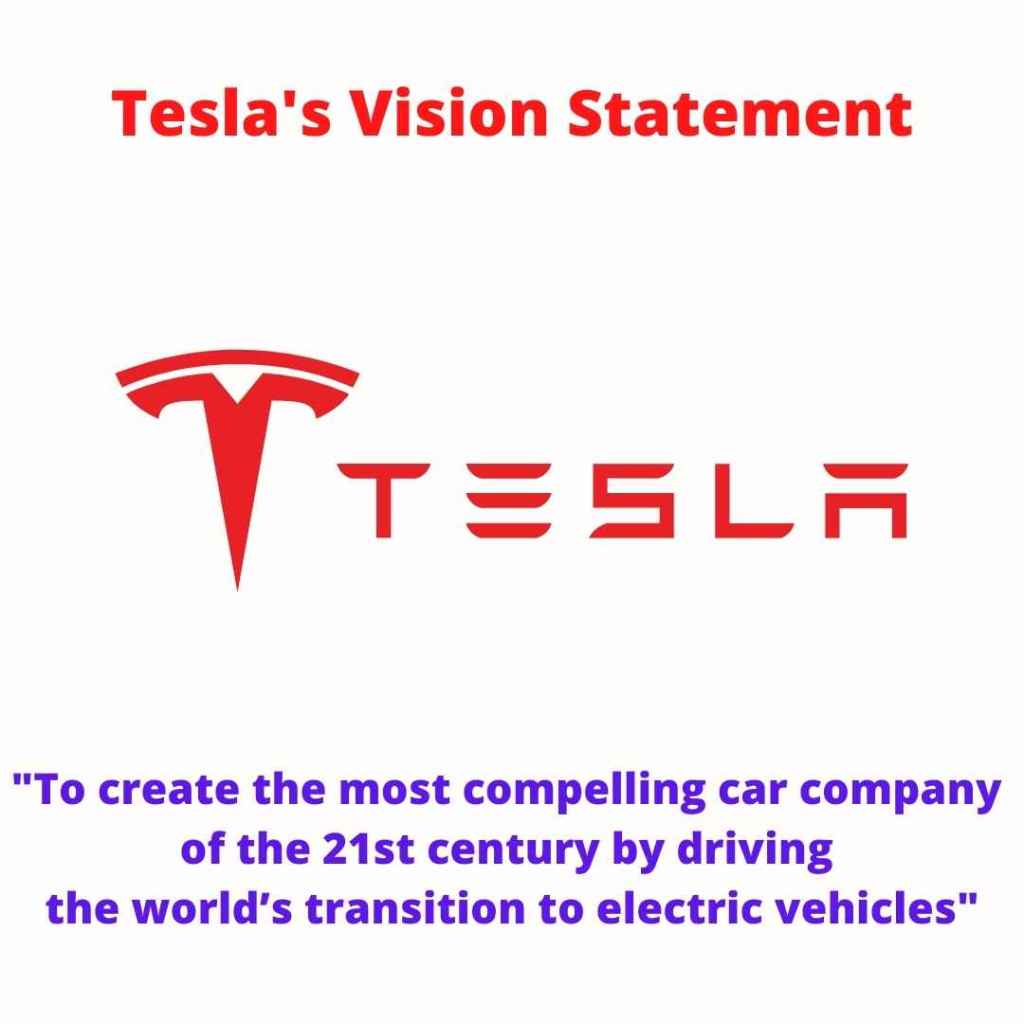
Inspire Uplift’s vision statement is: “We want to bring you products that you will love. We fulfill that vision by working around the clock to partner with product manufacturers offering the most interesting products available.”

However, we think they failed to communicate their vision here. It’s not clear as to what they want to become or achieve in the future. It should be something like: “To become the number one place for people to shop the most interesting products by working around the clock with top manufacturers.”
Remember, your vision statement should serve as an inspiration to move your dropshipping brand forward.
4. Come Up with Your Brand Core Values
Your brand core values are the beliefs that guide your brand actions, behaviors, and decision-making process. It essentially answers the question: “What do we stand for?.”
Let’s look at some examples first so you understand this concept better.
Starbucks has 4 core values stated in their website.
- Respect for Culture: Creating a culture of warmth and belonging, where everyone is welcome.
- Teamwork: Delivering our very best in all we do, holding ourselves accountable for results.
- Perseverance: Acting with courage, challenging the status quo, and finding new ways to grow our company and each other.
- Integrity: Being present, connecting with transparency, dignity, and respect.
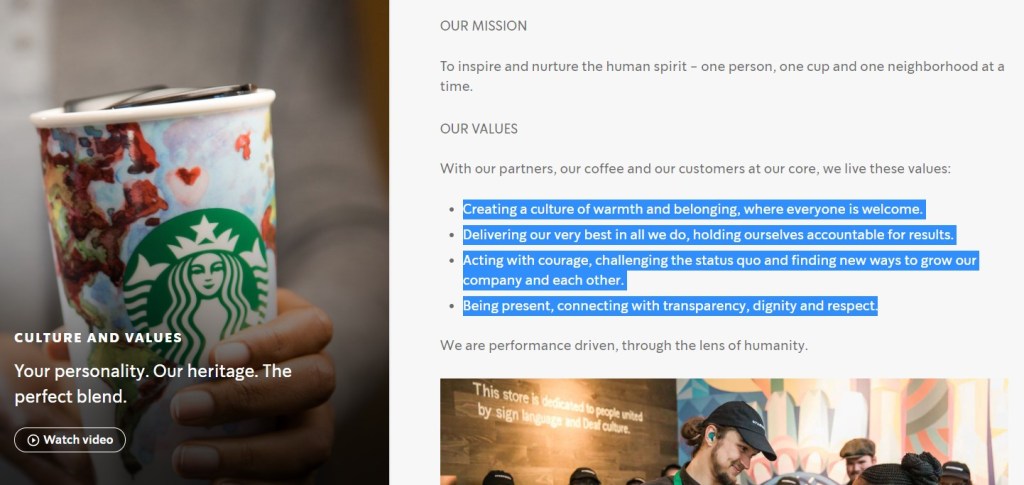
Unlike Starbucks, which focuses on building human connection, Youtube’s core values center around freedom.
- Freedom of Expression: People should be able to speak freely, share opinions, and foster open dialogue.
- Freedom of Information: Everyone should have easy and open access to information.
- Freedom of Opportunity: Everyone should have a chance to be discovered, build a business and succeed on their own terms.
- Freedom to Belong: Everyone should be able to find communities of support and come together around shared interests and passions.
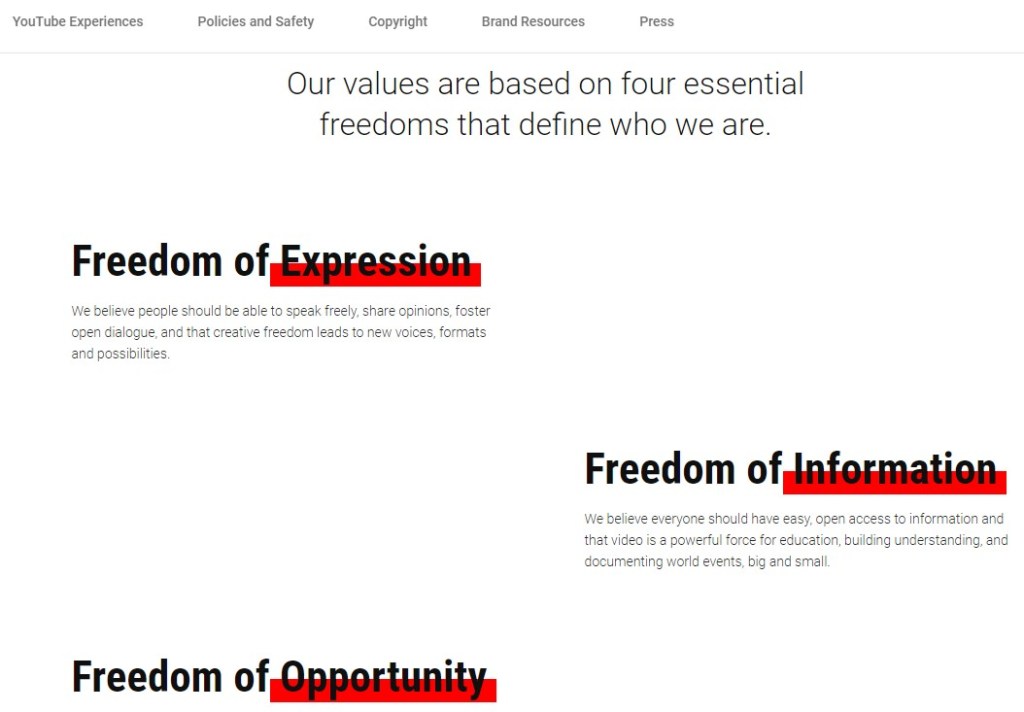
In a Harvard Business study, 64% of customers who said they have a brand relationship cited shared values as the primary reason. Meanwhile, only 13% attributed frequent interactions with the brand as a reason for having a relationship.
So, how do you come up with brand core values for your dropshipping store?
Start by picking 4-5 principles closely related to your brand purpose. Here is a list of 18 common ones:
- Integrity
- Boldness
- Honesty
- Trust
- Accountability
- Commitment to Customers
- Passion
- Fun
- Humility
- Continuous Learning
- Ownership
- Constant Improvement
- Leadership
- Diversity
- Innovation
- Quality
- Teamwork
- Simplicity
If you feel like these aren’t enough, you can have a look at the 200 examples of principal brand values.
Then, expand the ideas into short sentences to suit your brand theme. For example, if you run a consumer electronics dropshipping business, you can pivot around constant improvement and innovation. One of the brand core values would be “Innovation: Continuously exploring new ideas to improve people’s life.”
5. Position Your Dropshipping Brand
Brand positioning is where your brand appears in the mind of customers. It means you must understand which segments of the market you’re targeting, what your competitors are, and how your brand is different from the rest. Brand positioning basically answers the question: “Where are we in the mind of customers?.“
Understand Your Target Segment
First, you have to define exactly what your target segment is. Or in other words, who are your target customers?
The more specific they are, the better it is.
A technique to define your target customers is to fill in an audience persona. It’s a detailed description of a fictional character who represents your best potential customers.
Below is an example.

A good persona contains at least these elements:
- Name
- Basic Demographics: Age, Gender, Occupation, Education, Location, Hobbies, and Family Status.
- Income Level
- Goals
- Challenges
- Media Consumption
- Needs and Values
- Story
You can also use Hubspot Make My Persona to quickly print out a beautiful persona for your dropshipping brand.
Research Your Competitors
Next is your competitors. By analyzing them, you will have a general idea of who you are up against, their strengths and weaknesses, what you can do better, and your chance of success.
There are 4 places you should look at when conduct dropshipping competitive research:
- ECommerce giants: Amazon, eBay, and Walmart.
- Other dropshipping stores.
- Social networks: Facebook, Instagram, and Pinterest.
- Reviews: Trustpilot.

The next section will tell you how to differentiate your dropshipping brand from the rest.
6. Differentiate Your Dropshipping Brand
Brand differentiation is how your brand is set apart from the crowd. Basically, it answers the question: “What makes customers buy from us instead of competitors?.“
For instance, Apple differentiates its brand through various factors, including exclusive technology, unique product design, high pricing strategy, and a rich ecosystem.
Regarding dropshipping, you can differentiate your brand with 7 main methods below.
Price Differently
Pricing your products lower or higher than your competitors is the most common way to persuade people to buy from your brand. Unless customers have specific preferences, they are more likely to buy the cheapest or most expensive products than the middle ones.

Niche Down
Going for a specific niche doesn’t only helps you differentiate your brand from a more general dropshipping store, it also reduces the competition.

Offer a Unique Purchasing Experience
By creating a unique and memorable purchasing experience through personalization, surprise factors, or thoughtful support, your customers will fall in love with your dropshipping brand and keep them coming back.

Develop a Unique Visual Identity
Designing your dropshipping store with a distinctive logo or quirky color palette can help make your brand more memorable.

Create Custom Packaging
Custom packaging is another method to help create a branded dropshipping store and also provides a great purchasing experience for your customers.
You can try asking your dropshipping suppliers about custom packing or ordering them from third-party companies like PackFactory or PackHelp.

Create Custom Products
With services like Printful or Printify, you can easily create custom branded products with your own logo and styles to start differentiating your dropshipping store from your competitors.

Challenge The Norm
What happens if you go against the normal things that everyone else is doing? You might get laughed at, and people might say you’re so silly. In a world that revolves so much around the internet, doing unusual things get you a lot of tractions. As long as what you do is ultimately harmless, you can go viral.
A prime example of brands that challenge the norm is no name. It strips away all the fancy stuff that you normally see from a proper brand. As a result, it blows up and becomes super successful.

7. Create Brand Personality
Brand personality is certain human characteristics that are associated with a particular brand. It serves as a stepping stone towards building a personal and tight relationship with your customers.
For example, we can attribute sophistication with Rolex and competence with Microsoft. Brand personality answers: “What do customers think of us as?.”
There’re 2 widely-used frameworks to help develop your brand personality.
The first one is the Aaker’s dimension framework, which consists of 5 key characteristics:
- Excitement: Daring, youthful, imaginative, etc.
- Sincerity: Honest, thoughtfulness, down-to-earth, and wholesome.
- Ruggedness: Brave, tough, outdoorsy, and athletic.
- Competence: Successful, reliable, hard-working, etc.
- Sophistication: Elegant, prestigious, and upper class.
You can also use a more sophisticated framework called the archetypes framework.
No matter which personality type you choose for your dropshipping brand, it should be consistently expressed through your visual identity, brand purpose, and core values.
8. Create Brand Emotion
Emotional branding refers to the process of building a brand that provokes certain emotions. It strengthens the human parts of the brand and helps form a lasting connection with customers.
In fact, Harvard Professor says that 95% of purchasing decisions are subconscious. We usually buy things on emotion and later justify with logic.
Brand emotion essentially solves the question: “What kinds of emotion we provoke?.”
A prime example of a company that has strong brand emotion is Calm. Just by looking at the name, you know how customers feel when using its application.

Before creating brand emotions for your dropshipping business, you should understand the basic human needs since they’re what evokes our emotions.
The 5 needs are, according to Maslow’s hierarchy of needs:
- Physiological: Air, water, food, shelter, sleep, clothing, and reproduction.
- Safety: Personal security, employment, health, and property.
- Love and Belonging: Friendship, intimacy, and sense of connection.
- Esteem: Respect, status, recognition, strength, and freedom.
- Self-Actualization: Desire to become the most that one can be.
People want to fulfill these desires, and leveraging them will help you establish a strong emotional brand.
9. Develop Brand Core Messages
Brand core messages covey the underlying value proposition of a brand. They act as a guideline for your marketing campaigns, product copy, store content, social media posts, press releases, and emails. They help you clear up the question: “What do we want customers to understand about us?.”
Brands often express core messages through taglines. For example, Nike’s brand messaging is “Just do it,” and Google’s is “Don’t be evil.”
In order to develop effective core messages, besides having a clear purpose or understanding brand positioning, there are 3 more elements to look at:
- Key Terms: What crucial words or expressions to use. For example, Apple often uses words like “different,” “innovation,” and “future” in its marketing campaigns.
- The Tone of Voice: How a brand character comes through in words, both written and spoken. It can be formal or informal, technical or non-technical, serious or cheerful, etc.
- Communication Guidelines: What to say, what not to say, how to refer to the public, spelling rules, length of text, etc.

10. Tell a Brand Story
A brand story is a narrative that encompasses events, facts, and feelings that creates and drives a brand until today. Unlike traditional advertising, which focuses on telling about a product, a story inspires an emotional reaction and deepens the bond between the brand and consumers.
As straightforward as it is, the brand story answers the question: “What is our story?.“
According to researchers, 92% of customers want brands to build marketing campaigns that feel like stories.
Similar to books and movies, a compelling brand story leaves a strong impression on your customers, and, ultimately, they will remember about your brand.

Many brands, especially dropshipping ones, often neglect this branding element. However, if you really want to build a long-term business that people care about, a brand story is a must-have. Remember, people buy on emotion and justify with logic.
When it comes to writing a compelling story for your store, the most widely-used framework is the hero’s journey. It contains 10 key parts:
- The conventional market
- Facing a challenge
- Rejecting the challenge
- Appointing the sage
- Crossing into the unfamiliar
- Mapping the road of challenges
- Facing the final challenge
- Looking back at the changes you’ve undergone
- Looking forward to new challenges through a changed outlook
- Celebrating your victory
Daily Steal – a popular dropshipping deal portal – also closely follows this brand storytelling framework.
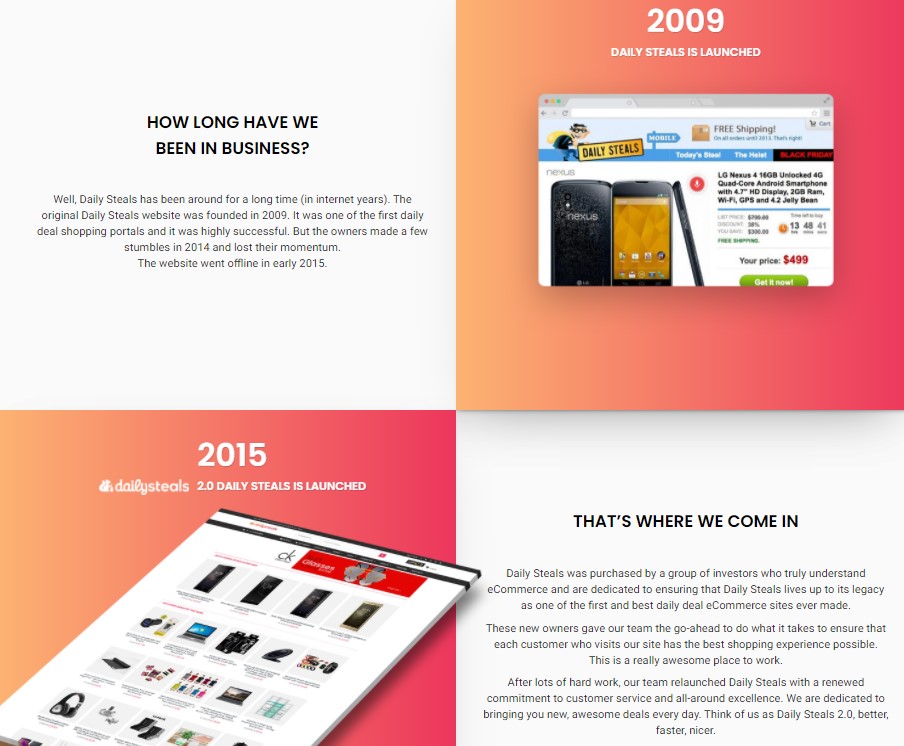
11. Develop an Image for Your Dropshipping Busines
Brand image is the idea and perception that people develop in their minds about a brand. It also indicates what they expect from the brand.
Brand image answers the questions “How do customers perceive us?.“
For instance, Apple has the image of a luxury brand. It could not make a budget smartphone as that would make customers confused and dilute its current image.

Another example is McDonald. It creates an image of an affordable brand that serves food fast.
When people have already developed an image for a brand, it’s nearly impossible to change that image. Trying to go against this would risk damaging your entire brand permanently. In fact, many big companies combat this problem by establishing a completely new brand to reduce the connection with the parent.
Some popular brand images you can pivot around are Affordable, Luxury, Premium, Fast, Original, Ideal (for indoors or outdoors), Lasting, Durable, etc.
12. Create a Brand Name and Tagline
The name and tagline (along with the logo) are the most distinctive and easily recognizable elements that separate one brand from another. That’s also the reason why when talking about branding, people usually only talk about them.
Brand Name
Every brand has a name.
A brand name refers to the word or words used to call and distinguish a company. Similar to a human, it answers one of the most critical questions in life: “What is our name?.“
On the surface, naming a brand may seem like an easy task. However, coming up with a strategic or even iconic one requires you to carefully incorporate all the previously mentioned branding elements such as your purpose, values, or even story.
Nowadays, a brand name is closely related to a domain name. Therefore, make sure you come up with one that the domain name for it exists. Also, it’s best to go with “.com” as it’s the most recognizable and trustworthy extension.
Here are some other tips when naming your dropshipping brand:
- Resonate with your niche.
- Short and memorable.
- Avoid hyphens (the “-” symbol) as it adds an additional layer of complexity when typing the name.
- Avoid numerical digits (1, 2, etc.) because it looks unprofessional.
- Use the correct spells of words to avoid confusion.
- Try synonyms, rhymes, or acronyms.
- Add a prefix pr suffix (-ify, -er, or -ize).
You can also use NameLix to help you quickly generate some name ideas for your business.
Tagline
A tagline is a catchphrase or slogan that briefly conveys your brand’s core messages. The purpose of it is to create a memorable and powerful communication tool that sticks with your brand. “What is our mantra?” is the question that a tagline answers.
Since by now, you should have your brand’s core messages in place, coming up with a great tagline might not be as much of a daunting task.
Having said that, here’re some quick tips to generate a great tagline for your dropshipping store:
- Keep it short and simple (“Think Different” – Apple)
- Focus on your brand purpose (“Connecting People” – Nokia)
- Talk about your vision (“The World”s Local Bank” – HSBC)
- Focus on benefits (“Shave Time. Shave Money” – Dollar Shave Club)
- Use a motivational phrase (“Go Further” – Ford)
- Describe the experience (“It’s finger-licking good” – KFC)
- Think about what emotions you want to evoke (“Open Happiness” – Coca Cola)
And Shopify has a great slogan maker tool if you want some quick ideas.
13. Develop a Visual Identity for Your Dropshipping Brand
The logo is not the only element to brand your dropshipping store visually. Others are your use of colors, typography, shapes, graphics, and layouts. Together, your brand visual identity elements solve the question: “What do we look like?.“
Color
First is the use of color.
Colors have strong impacts on the human brain and emotions. Certain colors mean certain things and have certain effects, depending on how a person uses them.
Take the color blue as an example. It’s a cool color, which usually reminds us of winter. It can also represent the sky and cleanliness. You will often see technology and medical brands like Dell, Visa, or Paypal use blue because it denotes trust, intelligence, and serenity.
Before deciding to work with a certain color, make sure you understand the meaning behind it.
Typography
Next is your brand typography.
Simply put, typography is the style of texts. Even though not as strong as colors, typography can affect the feeling of customers to your brand.
For example, display fonts like Script or Lobster are often used by apparel or jewelry brands because of the decorative nature. In contrast, classic-looking serif fonts like Times New Roman are the best choice for magazines and newspapers. Finally, sans-serif fonts are the most widely used ones on the internet due to their clean and modern appearance.
Shape
Along with colors and typography, you can use unique shapes to make your dropshipping brand more stand out.
Shape can make an immediate impact on human brain.
Circles spark the images of cooperation, unity, and friendship, making it an excellent choice for brands that focus on community (Like Starbuck). Meanwhile, triangles are the symbol for power, strength, and energy, which is suitable for brands that want to express those same emotions (Like Adidas).
Graphics (Images)
Graphics are another powerful force in designing your store. The cover, product photos, customer review images, or social post graphics contribute to the overall reaction of your customers towards your brand.
For example, in the case of clothing dropshipping brands, it’s sometimes better to use non-professional images featuring real people wearing the shirts. On the contrary, high-cost products like smartphones or laptops need high-quality photos focusing on their design.
Layout & Composition
Layout and composition are how you arrange your store content. Without a clear, structural, and consistent layout, it would confuse visitors, and they wouldn’t know what to look at.
For example, if you want to increase your conversion rate, make your CTA button bigger, clear in contrast, and place it where customers can easily see it.
Logo
A logo is the visual trademark of a brand. It’s one of the most important elements, if not the most important, that build brand recognition.
A good logo often communicates the brand purpose, value, or story just by looking at it.
With Amazon, it’s an arrow symbol that points from the letter “A” to “Z,” meaning the brand caters to customers everything.

A logo contains many components that cohesively put together, ranging from the featured symbol, typography, dominant color, layout, and sometimes text. That’s the reason why we purposely put the logo part at the end of this branding section.
Canva is a great free tool to help you design all kinds of graphics, including logos, for your dropshipping store.
14. Develop a Sensory Identity
Sensory identity refers to the branding process that evokes the basic senses of humans. It works as an additional emotional layer to further deepen the relationship between a brand and customers. Essentially, it answers: “What do we feel like?.“
Take popcorn as an example. When you smell it, what product or service do you think of? 99% of the time, your answer is movie theaters. That’s how powerful sensory identity is.
Another example is the iconic Apple ringtone “Marimba.” It’s so wired in our head that it becomes a sensory identity for Apple.
Besides the sense of sight, which we have discussed in the previous section, there’re 4 more:
- Sense of Touch (Marshmallows brands)
- Sense of Hearing (Windows startup sounds)
- Sense of Smell (Movie theaters and popcorn)
- Sense of Taste (Oreo and milk)
15. Establish Your Brand Presence and Communication
Brand presence and communication is the existence of a brand offline and online. The purpose is to inform, educate, and keep in touch with customers as much as possible. It answers: “Do customers know about us? And how?.”
For dropshipping stores, 4 channels to build brand presence and communication you should leverage the most are:
- Advertising (Facebook Ads, Google Ads, or Pinterest Ads)
- Social Media (Facebook, Instagram, Pinterest, or Snapchat)
- Blogging (Ranking your store on search results)
- Custom Packaging (Improve your brand presence offline)

Remember to play to your strength and don’t try to grow every channel at once. For example, if you see good results on Instagram, try to grow it first. Facebook or Pinterest can wait.
16. Strengthen Brand Experience
Brand experience encompasses everything that a customer goes through when seeing, purchasing, and using a brand. It literally describes: “How do customers experience us?.“
To build a good brand experience, especially for a dropshipping one, you need to focus on strengthen at least 4 core factors:
- Website Experience: Fast, secured, and easy to navigate.
- Customer Service: Fast and helpful email (or chat) response.
- Shipping: Fast shipping (or at least accurate shipping times).
- Returns & Refunds: It should be easy for customers to return and get refunded for their order.
One of the most well-known brands for its brand experience is Zappos. Right from the logo, which features “Powered by Service” and the tagline, “Delivering Happiness,” you can see how much the brand cares about its customers.
17. Build Brand Gap
The brand gap is the difference between what a brand promises and what it actually does. A successful brand should be able to deliver at least what it promises.
Retake Zappos as an example. The brand’s first core value is “Deliver WOW through service.” In fact, in 2009, a customer called the company to purchase a pair of shoes. Zappos headquarter didn’t have it in stock at the moment. So, they went to the nearby mall, buy one, and hand-delivered it to the customer. An insane customer service!

Brand gap answers the question: “Do we deliver what we promise?.“
To build the brand gap, you should at least be honest with your customers about shipping times, products, and where you get them.
In case you’re afraid of letting people know that you’re a dropshipping brand, here are ways to tell customers you’re dropshipping without explicitly saying it.
18. Improve Brand Capital
Brand capital contains tangible and intangible resources a brand possesses, such as funds, human capital, inventory, technology, digital documents, or other types of assets.
A brand needs to understand what it has in hand to realistically set marketing and development goals.
Brand capital answers: “What do we have?.“
For example, if you dropship on Shopify, your brand capital might contain yourself (and your team), Shopify license, Shopify app license, theme license, and your funds to run ads. It might also include your inventory if you buy products in bulk and designs of print-on-demand items.
19. Develop Brand Culture
Brand culture refers to the customs and behaviors that a brand cultivates for people to work together so they can bring the best value to customers. Usually, brand culture naturally expresses through all branding elements like brand purpose, core values in addition to leisure activities and working conditions.
Simply put, you need to solve the question: “What is our culture?.“
Generally speaking, you don’t really need to focus on developing a culture until you have a large team. However, having a culture set in place early can significantly motivate every member to move forwards and achieve the same goals. Furthermore, a brand culture helps you employ people who are appropriate for your company.
20. Be Careful with Brand Extension
Brand extension refers to when a brand goes beyond what’s known as and exploring new products or categories.
This state happens to every company. After all, the brand’s ultimate goal is to make more profits, and expand to new ideas will help achieve that.
Before expanding your brand, ask yourself: “How do we expand? And how would customers react?.“
For example, it would be weird if you originally dropship jewelry then later listing gym equipment on your online store. As mentioned earlier, doing that risks damaging your current brand image.
When your brand has already developed an image in customers’ minds, it might be better to establish an entirely new brand for new products to avoid damaging the original image.
For instance, Coca-Cola created the Sprite and Fanta brand because they were different types of soft drinks.

Another important thing to note is that line extension and brand extension are two different things. In line extension, a brand expands its existing product line, like Coca-Cola introduces new “Coca-Cola Zero” flavor.
Dropshipping Branding Checklist
Finally, you need to tie everything you have learned together. Make sure that they’re consistent and cohesive.
Here is a dropshipping branding checklist to double-check your results.
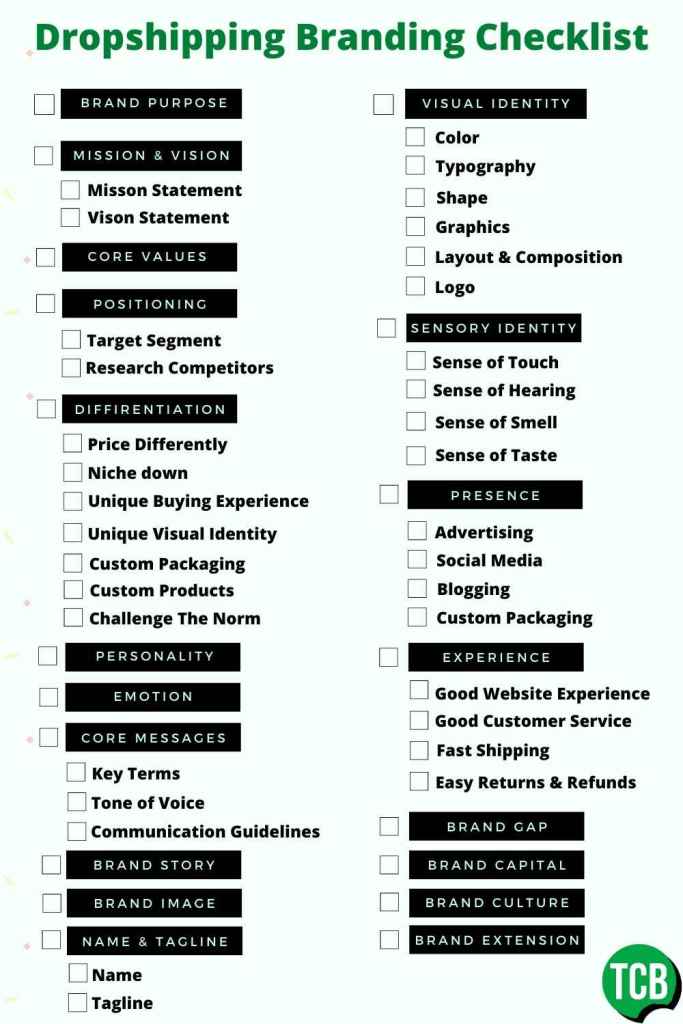
Conclusion
Branding doesn’t stop at a beautiful logo or a catchy tagline. It’s a cohesive combination of various elements, from your brand purpose, core values to your brand experience, culture, and extension.
And to give you a final touch, branding, at least for us, is all about becoming a human. That’s it! To turn your business into a person that people can relate to and care for.
Hopefully with our guideline, you will be able to build a strong dropshipping brand that your customers remember and love.
The rightful owner of The Clever Business. I review & curate the leading suppliers so you don't waste time scouring the internet.




